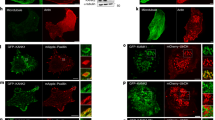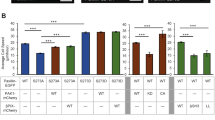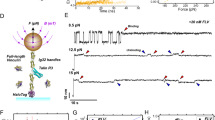Abstract
Dynamic regulation of adhesion complexes is required for cell migration and has therefore emerged as a key issue in the study of cell motility1. Recent progress has been made in defining some of the molecular mechanisms by which adhesion disassembly is regulated, including the contributions of adhesion adaptor proteins and tyrosine kinases2. However, little is known about the potential contribution of proteolytic mechanisms to the regulation of adhesion complex dynamics. Here, we show that proteolysis of talin by the intracellular calcium-dependent protease calpain is critical for focal adhesion disassembly. We have generated a single point mutation in talin that renders it resistant to proteolysis by calpain. Quantification of adhesion assembly and disassembly rates demonstrates that calpain-mediated talin proteolysis is a rate-limiting step during adhesion turnover. Furthermore, we demonstrate that disassembly of other adhesion components, including paxillin, vinculin and zyxin, is also dependent on the ability of calpain to cleave talin, suggesting a general role for talin proteolysis in regulating adhesion turnover. Together, these findings identify calpain-mediated proteolysis of talin as a mechanism by which adhesion dynamics are regulated.
This is a preview of subscription content, access via your institution
Access options
Subscribe to this journal
Receive 12 print issues and online access
$209.00 per year
only $17.42 per issue
Buy this article
- Purchase on Springer Link
- Instant access to full article PDF
Prices may be subject to local taxes which are calculated during checkout




Similar content being viewed by others
Accession codes
References
Webb, D.J., Brown, C.M. & Horwitz, A.F. Illuminating adhesion complexes in migrating cells: moving toward a bright future. Curr. Opin. Cell Biol. 15, 614–620 (2003).
Webb, D.J. et al. FAK–Src signalling through paxillin, ERK and MLCK regulates adhesion disassembly. Nature Cell Biol. 6, 154–161 (2004).
Webb, D.J., Parsons, J.T. & Horwitz, A.F. Adhesion assembly, disassembly and turnover in migrating cells — over and over and over again. Nature Cell Biol. 4, E97–E100 (2002).
Dourdin, N. et al. Reduced cell migration and disruption of the actin cytoskeleton in calpain-deficient embryonic fibroblasts. J. Biol. Chem. 276, 48382–48388 (2001).
Glading, A., Lauffenburger, D.A. & Wells, A. Cutting to the chase: calpain proteases in cell motility. Trends Cell Biol. 12, 46–54 (2002).
Bhatt, A., Kaverina, I., Otey, C. & Huttenlocher, A. Regulation of focal complex composition and disassembly by the calcium-dependent protease calpain. J. Cell Sci. 115, 3415–3425 (2002).
Glading, A., Chang, P., Lauffenburger, D.A. & Wells, A. Epidermal growth factor receptor activation of calpain is required for fibroblast motility and occurs via an ERK/MAP kinase signaling pathway. J. Biol. Chem. 275, 2390–2398 (2000).
Nayal, A., Webb, D.J. & Horwitz, A.F. Talin: an emerging focal point of adhesion dynamics. Curr. Opin. Cell Biol. 16, 94–98 (2004).
Giannone, G., Jiang, G., Sutton, D.H., Critchley, D.R. & Sheetz, M.P. Talin1 is critical for force-dependent reinforcement of initial integrin-cytoskeleton bonds but not tyrosine kinase activation. J. Cell Biol. 163, 409–419 (2003).
Jiang, G., Giannone, G., Critchley, D.R., Fukumoto, E. & Sheetz, M.P. Two-piconewton slip bond between fibronectin and the cytoskeleton depends on talin. Nature 424, 334–337 (2003).
Priddle, H. et al. Disruption of the talin gene compromises focal adhesion assembly in undifferentiated but not differentiated embryonic stem cells. J. Cell Biol. 142, 1121–1133 (1998).
Calderwood, D.A. et al. The phosphotyrosine binding-like domain of talin activates integrins. J. Biol. Chem. 277, 21749–21758 (2002).
Tadokoro, S. et al. Talin binding to integrin β tails: a final common step in integrin activation. Science 302, 103–106 (2003).
Yan, B., Calderwood, D.A., Yaspan, B. & Ginsberg, M.H. Calpain cleavage promotes talin binding to the β3 integrin cytoplasmic domain. J. Biol. Chem. 276, 28164–28170 (2001).
Ling, K., Doughman, R.L., Firestone, A.J., Bunce, M.W. & Anderson, R.A. Type I γ phosphatidylinositol phosphate kinase targets and regulates focal adhesions. Nature 420, 89–93 (2002).
Franco, S., Perrin, B. & Huttenlocher, A. Isoform specific function of calpain 2 in regulating membrane protrusion. Exp. Cell Res. 299, 179–187 (2004).
Huttenlocher, A. et al. Regulation of cell migration by the calcium-dependent protease calpain. J. Biol. Chem. 272, 32719–32722 (1997).
Fincham, V.J. & Frame, M.C. The catalytic activity of Src is dispensable for translocation to focal adhesions but controls the turnover of these structures during cell motility. EMBO J. 17, 81–92 (1998).
Ilic, D. et al. Reduced cell motility and enhanced focal adhesion contact formation in cells from FAK-deficient mice. Nature 377, 539–544 (1995).
Stabach, P.R., Cianci, C.D., Glantz, S.B., Zhang, Z. & Morrow, J.S. Site-directed mutagenesis of αII spectrin at codon 1175 modulates its μ-calpain susceptibility. Biochemistry 36, 57–65 (1997).
O'Halloran, T., Beckerle, M.C. & Burridge, K. Identification of talin as a major cytoplasmic protein implicated in platelet activation. Nature 317, 449–451 (1985).
Ruoslahti, E., Hayman, E.G., Pierschbacher, M. & Engvall, E. Fibronectin: purification, immunochemical properties, and biological activities. Methods Enzymol. 82, A 803–831 (1982).
Rees, D.J., Ades, S.E., Singer, S.J. & Hynes, R.O. Sequence and domain structure of talin. Nature 347, 685–689 (1990).
Huttenlocher, A., Ginsberg, M.H. & Horwitz, A.F. Modulation of cell migration by integrin-mediated cytoskeletal linkages and ligand-binding affinity. J. Cell Biol. 134, 1551–1562 (1996).
Zamir, E. et al. Molecular diversity of cell-matrix adhesions. J. Cell Sci. 112, 11 1655–1669 (1999).
Chen, Y.P. et al. “Inside-out” signal transduction inhibited by isolated integrin cytoplasmic domains. J. Biol. Chem. 269, 18307–18310 (1994).
Acknowledgements
We would like to thank M. Ginsberg and R. Anderson for reagents and useful discussions, and J. Byrnes for technical assistance. This research was supported by National Institutes of Health grants R01CA85862-01 (A.H.) and T32GM07215-25 (S.J.F. and B.J.P.). Work in the laboratory of D.R.C. was funded by the Wellcome Trust.
Author information
Authors and Affiliations
Corresponding author
Ethics declarations
Competing interests
The authors declare no competing financial interests.
Supplementary information
Supplementary Figures
Fig. S1, Fig. S2, Fig. S3, Fig. S4 and Fig. S5 (PDF 323 kb)
Rights and permissions
About this article
Cite this article
Franco, S., Rodgers, M., Perrin, B. et al. Calpain-mediated proteolysis of talin regulates adhesion dynamics. Nat Cell Biol 6, 977–983 (2004). https://doi.org/10.1038/ncb1175
Received:
Accepted:
Published:
Issue Date:
DOI: https://doi.org/10.1038/ncb1175
This article is cited by
-
Organization, dynamics and mechanoregulation of integrin-mediated cell–ECM adhesions
Nature Reviews Molecular Cell Biology (2023)
-
Protein dynamics at invadopodia control invasion–migration transitions in melanoma cells
Cell Death & Disease (2023)
-
A genome-wide in vivo CRISPR screen identifies essential regulators of T cell migration to the CNS in a multiple sclerosis model
Nature Neuroscience (2023)
-
The key role of Calpain in COVID-19 as a therapeutic strategy
Inflammopharmacology (2022)
-
Critical role of lipid membranes in polarization and migration of cells: a biophysical view
Biophysical Reviews (2021)



